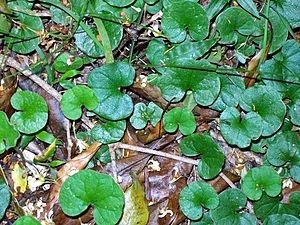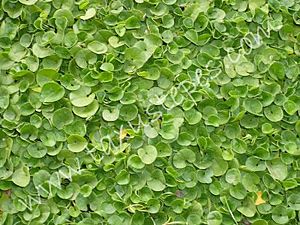Kidney weed facts for kids
Quick facts for kids Kidney weed |
|
|---|---|
 |
|
| At Eastwood, Australia | |
| Scientific classification | |
| Genus: |
Dichondra
|
| Species: |
repens
|
Dichondra repens is a small plant that grows close to the ground. It is a type of herb and is native to New Zealand and many parts of Australia. People sometimes call it kidney weed in Australia. In New Zealand, it is known as Mercury Bay weed. Most often, people just call it dichondra.
This plant often grows in forests, woodlands, and grasslands. You might also find it in lawns. Sometimes it is planted on purpose, but it can also grow there like a weed. In places like California and parts of China, it has spread from gardens and now grows wild in some areas.
Contents
About This Plant
Dichondra repens was first described by two German naturalists, Johann Reinhold Forster and Georg Forster. They gave it the name repens, which is a Latin word meaning "creeping." This name fits the plant well because it spreads along the ground. The first plant they studied was found in New Zealand. This plant belongs to the Morning Glory Family, called Convolvulaceae.
What Dichondra repens Looks Like
This plant is a perennial herb, meaning it lives for more than two years. It has a creeping habit, which means it grows along the ground. Roots can form at different points along its stems.
The leaves are shaped like a kidney or are almost round. They are about 0.5 to 2.5 cm (0.2–1 in) long. The bottom of the leaf looks like a heart, and the top is rounded. Both the top and bottom of the leaves are covered in tiny, fine hairs.
Its tiny, yellowish-green flowers can appear all year round. They are most common from September to February, with the most flowers appearing in November. After the flowers, the plant produces a hairy fruit. This fruit is a two-part capsule.
Where It Grows
Dichondra repens is found in South Africa. It also grows in all mainland Australian states and Tasmania. In New South Wales, it is common in the eastern and central parts of the state.
It prefers to grow in flat areas of forests. It likes clay or clay-based soils that have a medium to high amount of nutrients. In New South Wales, you might find it growing with trees like river peppermint (Eucalyptus elata), thin-leaved stringybark (E. eugenioides), woollybutt (E. longifolia), and snow-in-summer (Melaleuca linariifolia).
Plant Uses and Wildlife
This plant is grown as an ornamental plant in gardens. People often use it as a lawn substitute or as groundcover. It can create a green or even grey carpet-like look in gardens.
The native Pacific black duck (Anas superciliosa) likes to eat the seeds of Dichondra repens.
Images for kids
See also
 In Spanish: Dichondra repens para niños
In Spanish: Dichondra repens para niños



